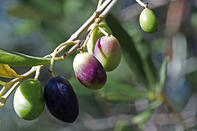Olive oil is extracted from the fruit of the olive tree (Olea europaea), which is native to countries around the Mediterranean Sea.

A versatile oil, it is used in food, as cooking oil, in cosmetics, in religious rituals, as a lubricant and as a base in detergents and soap.
Olive oil, especially extra virgin olive oil (EVOO), has many health benefits, such as has high levels of polyphenols, which function as both antioxidants and anti-inflammatories, which may reduce the risk of type II diabetes and prevent strokes and breast cancer.
What is Extra-Virgin Olive Oil?
EVOO is the top grade of olive oil. This term does not refer to a specific olive oil variety or harvesting time, but rather indicates the method of oil extraction. In order to be classified as extra virgin, the oil must be derived from the first press of the freshly harvested and undamaged olive fruit.
During this process, no chemicals or excessive heat are used. Once the oil has been extracted, it is tested to ensure it conforms to “extra virgin standards. This includes chemical requirements such as free fatty acid and peroxide levels. EVOO has a free acidity level of below 0.8%.
Classes of Olive Oil
As mentioned above, EVOO is the best quality of olive oil.
Virgin Olive Oil is a natural unrefined olive oil with minimal defects and a free acidity of between 0.8 and 2%. (Acidity, a measure of the quality of olive oil, measures the amount of free fatty oleic acid, which is the most abundant acid in olive oil.)
‘Cold press’ or ‘cold extracted’ means that the extraction temperatures were kept under 28°C. These low temperatures prevent the loss of the temperature-sensitive vitamins, antioxidants and flavour compounds.
Refined or light olive oil is the classification of oil, which has been deodorised and bleached. This results in an almost transparent oil of very subtle flavour and with lower health benefits than extra virgin oil is known for. These ‘light’ olive oils refer only to the colour and flavour and do not mean it is ‘light’ in kilojoules or that it is a diet product. All classes of olive oil have the same kilojoule content. Terms such as ‘pure’ or ‘100% pure’ are marketing terms and indicates that the oil is a refined oil.
‘Olive pomace oil’ is an oil that was chemically extracted from solid waste - pips, skin and flesh - left from the olive pressing process. It cannot be classified as ‘olive oil’, specifically not as ‘pomace olive oil’ a classification (wrongly) found on labels.
Styles of Extra Virgin Olive Oil
Extra virgin olive oil is categorized according to three styles – intensely fruity, medium intensity and delicate oils. The style is largely influenced by the specific olive varieties, if it is a single-varietal oil or cultivars used in the blend. In addition, the ripeness of the olives, production area, soil and the season’s weather all play a role in the final oil’s style. Young olives can contribute fruity nuances, like green apples and peaches, while riper olives can present notes of pineapple and banana.
The ‘delicate’ style olive oil is recommended for use in mayonnaise, vinaigrettes and on fruit. The fruity style olive oil is suitable for preparing meats, sautéing garlic and onions, soup and even for ice cream. While the medium intensity style is well-suited to use with chicken, fish, salads or in baking.
SA Olive lists the following well-known olive varieties used for different styles of oil:
Leccino – soft, subtle herbaceous flavours.
Frantoio – most planted in SA, strong green overtones.
Coratina – can produce a rather bitter oil.
Favolosa – produces an intensely fruity oil.
Mission – a table olive variety, can be used to contribute to roundness in a blend.
By Marinda Louw